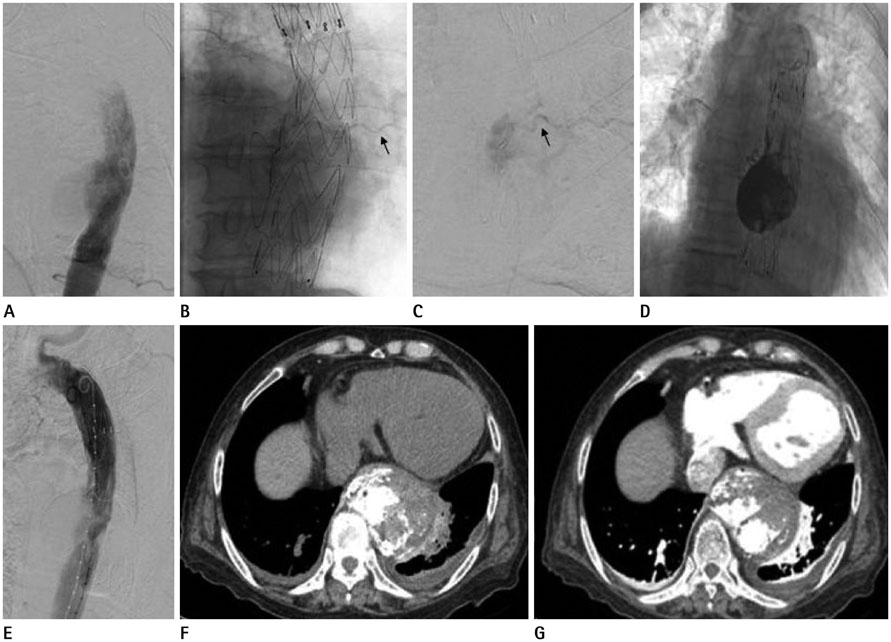J Korean Soc Radiol.
2014 Dec;71(6):310-313. 10.3348/jksr.2014.71.6.310.
Endovascular Treatment of Type II Endoleak Following Thoracic Endovascular Aortic Repair for Thoracic Aortic Aneurysm: Case Report of Squeeze Technique to Reach the Aneurysmal Sac
- Affiliations
-
- 1Department of Radiology, Pusan National University Hospital, School of Medicine, Pusan National University, Busan, Korea. radkim@nate.com
- 2Department of Thoracic and Cardiovascular Surgery, Pusan National University Hospital, School of Medicine, Pusan National University, Busan, Korea.
- KMID: 1801554
- DOI: http://doi.org/10.3348/jksr.2014.71.6.310
Abstract
- Type II endoleaks are common after thoracic endovascular aortic repair (TEVAR). Various strategies are introduced to manage type II endoleaks, such as the use of coils, plugs, or liquid embolic agents (histoacryl, thrombin, onyx, etc.) through a transarterial approach or a direct puncture of the aneurysmal sac. We herein report a case of a type II endoleak caused by reverse blood flow through intercostal artery after TEVAR which was successfully treated with n-butyl cyanoacrylate (histoacryl)-lipiodol mixture by a squeeze technique to reach the aneurismal sac using a microcatheter.
MeSH Terms
Figure
Reference
-
1. Parmer SS, Carpenter JP, Stavropoulos SW, Fairman RM, Pochettino A, Woo EY, et al. Endoleaks after endovascular repair of thoracic aortic aneurysms. J Vasc Surg. 2006; 44:447–452.2. Tanasoontornrerk A, Wasinrat J, Siriapisith T, Slisatkorn W. CT angiography evaluation of endoleak after thoracic endovascularaortic repair in thoracic aortic aneurysm. J Med Assoc Thai. 2010; 93:1050–1057.3. Sucandy I, Kim H, Sullivan TR. Endovascular management of the patent inferior mesenteric artery in two cases of uncontrolled type II endoleak after endovascular aneurysm repair. N Am J Med Sci. 2011; 3:387–390.4. Morales JP, Greenberg RK, Lu Q, Cury M, Hernandez AV, Mohabbat W, et al. Endoleaks following endovascular repair of thoracic aortic aneurysm: etiology and outcomes. J Endovasc Ther. 2008; 15:631–638.5. Shah A, Stavropoulos SW. Treatment strategies for Type 2 endoleaks after endovascular aneurysm repair. Acta Chir Belg. 2007; 107:356–360.6. Stavropoulos SW, Tucker J, Carpenter JP. Thoracic endoleak embolization using a direct percutaneous puncture of the endoleak through lung parenchyma. J Vasc Interv Radiol. 2009; 20:1248–1251.7. Alsac JM, Khantalin I, Julia P, Achouh P, Farahmand P, Capdevila C, et al. The significance of endoleaks in thoracic endovascular aneurysm repair. Ann Vasc Surg. 2011; 25:345–351.8. Wilmot A, Stavropoulos SW. Embolization of a Recurrent Type 2 Endoleak Using the Liquid Embolic n-Butyl Cyanoacrylate. Semin Intervent Radiol. 2007; 24:38–42.
- Full Text Links
- Actions
-
Cited
- CITED
-
- Close
- Share
- Similar articles
-
- Visceral Debranching Thoracic Endovascular Aneurysm Repair for Chronic Dissecting Thoracoabdominal Aortic Aneurysm
- Late Type 3b Endoleak Mimicking Type 2 Endoleak after Endovascular Aortic Aneurysm Repair
- Endovascular Repair of Thoracic Aortic Aneurysm Using a Custom-made Fenestrated Stent Graft to Preserve the Left Subclavian Artery
- Retrograde Aortic Dissection after Thoracic Endovascular Aortic Repair for Descending Aorta: 2 case reports
- Off-the-Shelf, Hybrid, Innominate Chimney Thoracic Endovascular Aneurysm Repair for Treatment of Mycotic Thoracic Aortic Aneurysm: A Case Report




